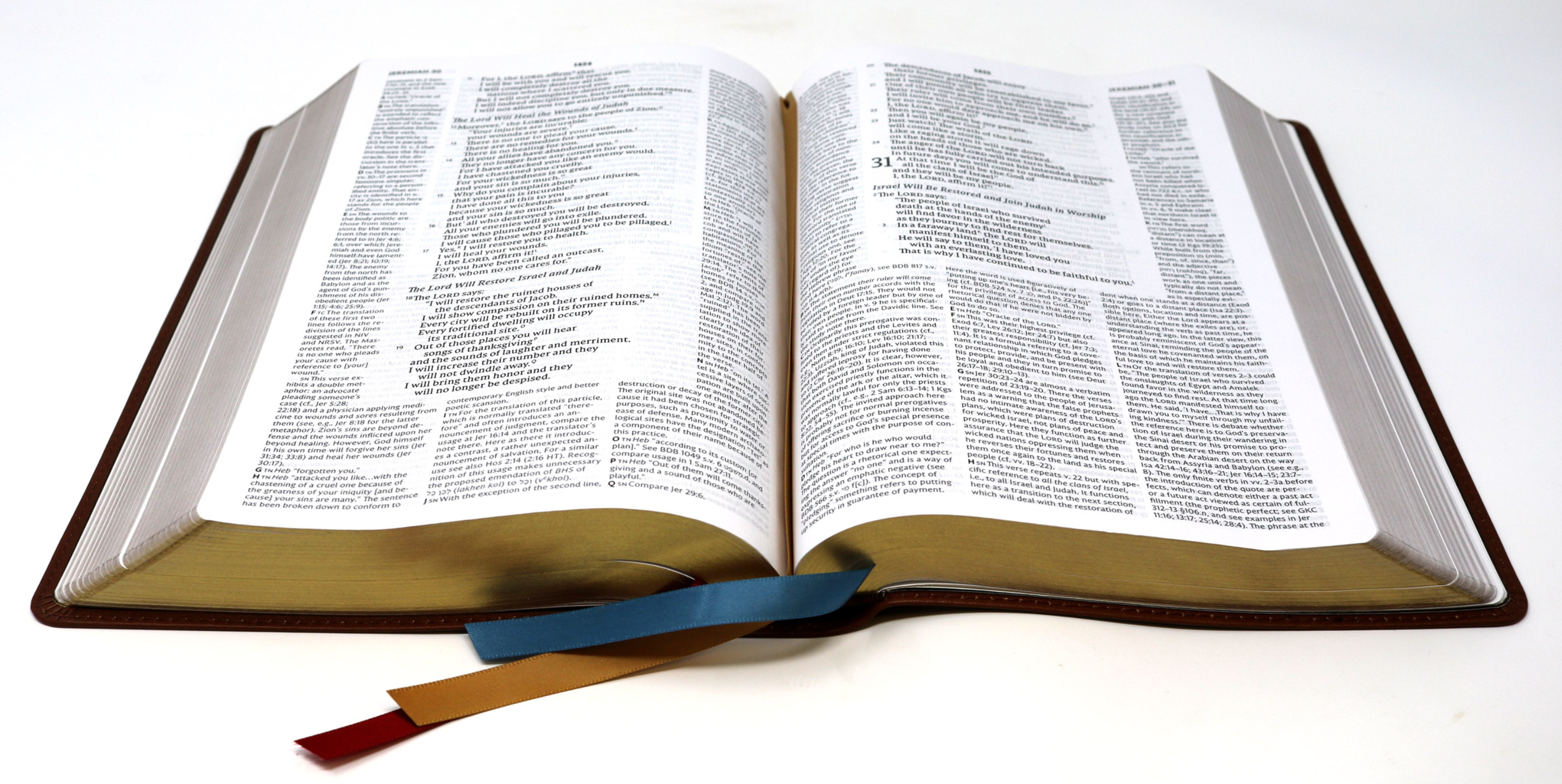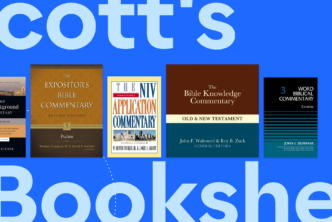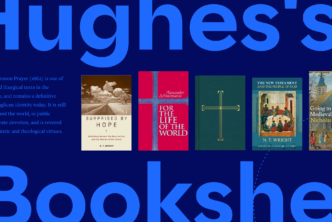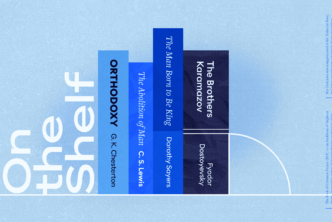In my last piece we looked at some qualities that make for a good study Bible. Now it’s time to look at some things that I’d love to see Bible publishers stop doing when putting together a study Bible. Though ’tis no longer the hallowed season of Festivus, nevertheless it’s time for an airing of my top ten Bible-nerd grievances!
10. Availability in only one translation
I know that publishers can only publish study Bibles in translations that they license from the copyright holder (and I know that the ethics of copyrighting a Bible translation are an entirely different subject for a different day!). But there’s a reason why Bibles like the Life Application or Thompson Chain Reference are perennial best sellers.
A study Bible can have incredible content and be wonderfully useful, but if it’s only available in a single translation it automatically limits its potential readership to those who use that translation. As lamentable as it is, Bible translation tribalism is a real thing.
So being able to point someone to a really good study Bible knowing that it is available in multiple translations is super helpful. I really would love to see publishers and translation copyright holders somehow work together to do a better job of making the various translations available in the various study Bibles produced for the benefit of Christ’s Body.
9. Tissue-thin paper
Is there anything worse than dropping a fresh highlight onto your favorite passage or underlining a word only to see it staring back at you when you turn the page, like some mirror-universe apparition? Or seeing the text and images from the other side of the page bleeding through while you’re trying to read?
Okay, there are a lot of things worse than these, I realize. This definitely falls into the “first-world problems” category. But seriously, it’s annoying and deserving of the above hyperbole!
Yes, publishers have so many factors to weigh when determining financial feasibility, but quality paper seems like it should be near the top of the list for a good publisher. I’ve seen some well-designed study Bibles end up nearly unreadable because they were basically printed on single-ply toilet tissue to save money. (Funny enough, I’ve never had this problem in Logos!)
8. Distracting or cramped page layouts
Let’s turn from good design to bad design for a moment.
As my friend and fellow YouTuber, Mark Ward, has pointed out, Bible typography matters! Whether it’s thin, hard-to-read fonts; text that falls into the gutter; study notes that are indistinguishable from Scripture text; blocks of annotations all running together; or overall lack of margin space (to save money?), bad graphic design can make even the most well-written material much harder to read.
Good study Bibles need not be flashy or visually trendy, but they should be laid out with artistic visual competence in a way that highlights what is most important and allows readers to easily and at-a-glance find material on the page.
I’ve seen many well-written study Bibles that are a visual labyrinth. But those that employ solid graphic design principles make the text that much more enjoyable to study! If Klaus Erik Krogh and his team at 2K/Denmark can make the NET Bible look good with its huge profusion of notes, other publishers can surely do better.

7. Unknown contributors
One of the main reasons I review study Bibles on my YouTube channel is because most people shopping for one have little to no familiarity with the contributors or their backgrounds. When it comes to teaching Scripture, it is important to know from whom we are learning.
Anonymous Bible teaching provides very little accountability, and since most study Bibles don’t include primary source footnotes in their study material, knowing where an interpretation or piece of background information is coming from is an important means to discern the overall reliability of what we are reading.
This is not to say that every contributor needs to have their résumé and personal doctrinal statement listed in an appendix. But knowing who has produced the study material we are using goes a long way towards building trust among discerning readers.
6. Celebrity preacher Bibles
On the other end of the spectrum from unknown Bible contributors, we have the phenomenon of the celebrity preacher/teacher/author study Bible. Now, don’t get me wrong—there are some gifted preachers and teachers out there. But no one person has the biblical knowledge necessary to cover the entire Bible.
Sure, a Bible may sell well if the celebrity whose name is on the cover has a large following. But I much prefer a study Bible with contributions from a team of scholars with diverse expertise.
5. Gimmick Bibles
Speaking of icky, can we talk about gimmick Bibles? Do we really need Bibles where every verse is color-coded to match a specific theme (as if each verse was ever its own freestanding unit of thought dealing with only one concept to begin with)?
When studying the Word of God, does it matter what America’s Founding Fathers (most of whom were deists) had to say about civil religion? Do the Declaration of Independence and Pledge of Allegiance have any place whatsoever in the pages of Scripture? This is inspired Holy Writ we are talking about.
4. Patronizing marketing to women
This is a common grievance I hear from women who are looking for study Bibles. Many of the Bibles marketed to women have noticeably less intellectual or academic depth than non-gendered study Bibles.
There is almost an unspoken assumption within the publishing landscape that women don’t want to learn—they just want to feel. They want journaling and coloring and daily inspirational quotes to share on Instagram, not commentary and word studies and exegetical insights. I say that this is an “unspoken assumption” because, obviously, no publisher would ever come out and say this. But having reviewed nearly a hundred study Bibles over the past few years, this is absolutely the impression I’m left with.
Thankfully, there are some study Bibles in the works featuring some wonderful biblical scholars who write as women and to women, and I’m hoping that this signals something of a sea-change in the study Bible landscape. I know for certain that there are countless women out there who hunger for more hermeneutical resources and scholarly depth than is currently being marketed to them.
3. Theologically inconsistent notes and maps
Something I didn’t really notice until I started reviewing the content of study Bibles professionally is just how often the notes in different parts of the same Bible will contradict notes in other parts of it.
For example, more than one study Bible I’ve reviewed will have study notes in one passage which lean complementarian while, in another passage, they lean egalitarian. They will provide readers with a premillennial interpretation in one book and an amillennial interpretation in another. They will talk about various routes of the Exodus, yet the map in the back will not reflect this ambiguity.
To be clear, I believe a good study Bible should provide readers with a range of options when it comes to interpretive issues. But if it is not made clear by the editor that passages are being interpreted differently by different contributors, this can lead to confusion among those readers who are not familiar with the hermeneutical landscape.
2. Sparse annotations and simplistic book intros
The entire purpose of a study Bible is to provide insight and background knowledge that readers may not be aware of for the purpose of better illuminating the message of Scripture. This is a daunting task, and every editorial team has to be highly selective in choosing what to include and what to leave out. But few things are as frustrating to me as something that is marketed as a study Bible but contains barely any actual study material.
A few annotations at the bottom of each page, single-paragraph book introductions, and occasional devotional essays fall so far short of what a good study Bible should provide. A study Bible should introduce the reader to the literary, historical, and theological landscape of each biblical book. Like a skilled tour guide, its notes and study material should serve to highlight key features of that landscape and point out things that might otherwise get overlooked by the untrained eye.
Notes that simply define random words, rephrase what the text says, or make no attempt to tie together the overarching themes of the book do little to help the exegetically hungry reader. Yet this is often what I’ve found when reviewing many of them.
1. Avoiding hard passages or hermeneutical differences
This brings us to the final grievance on my list. I can’t tell you how many times I’ve read a difficult passage, had a question about how to approach it, looked down at the study notes—and found absolutely nothing!
Let’s face it, the Bible is full of things that are, in the words of Peter himself, “hard to understand” (2 Pet 3:16). Study Bibles exist to help readers understand such things as best we can. When study Bibles skim over—or ignore altogether—difficult passages, they are simply not doing the main thing they exist to do.
Now, I don’t expect a study Bible to fully explain everything about the Nephilim, baptism for the dead, the identity of the man of lawlessness, the physics of Joshua’s long day, what Paul means by “all Israel will be saved,” or whether Jude considered the book of Enoch to be inspired Scripture! But I do expect it to say something about these and so many other difficult passages.
And when there are passages about which faithful Christian interpreters have historically held differing views, a good study Bible should not shy away from presenting those views fairly and in a way that advocates of each would agree with. It is mind-boggling that one could spend months (or years) working on study notes to the book of Romans and not give an accurate summary of the different ways Christians have interpreted the “I” of Romans 7 throughout the past two millennia.
It seems like theological malpractice to create a study Bible that specifically avoids letting readers know that godly Christians come to differing conclusions on how the “days” of Genesis 1 are to be interpreted in light of scientific discoveries. But study Bibles that do not alert the reader to long-standing hermeneutical debates within the body of Christ are doing a disservice to their readers.
Again, this isn’t a call for exhaustive commentary on every verse—that is something one would need to consult a good commentary series for (two that I recommend for interested readers looking to dig deeper would be The Bible Speaks Today and The Tyndale Old Testament/New Testament Commentary); nor am I saying that study Bibles are wrong to advocate for a particular reading of a passage. However, good study Bibles should allow the reader to assess the necessary information fairly and accurately for themselves as they study and wrestle with the text. I genuinely believe this is the most basic and important purpose for which a study Bible exists.
There you have it
So there you have it. My top ten study Bible gripes. Some are matters of aesthetics, some are matters of marketing, and some are matters of real theological significance. I recognize the woeful subjectivity of any such list, of course. But as someone who reviews study Bibles on a daily basis as part of my job, these are things I find myself thinking about quite a bit more than the average person.
The good news is there are some excellent study Bibles out there that avoid almost all of the above shortcomings. And in our digital age, things like typography, graphic design, and access to scholarship is exponentially greater than ever before. My hope is that we as Bible “consumers” (both in the spiritual as well as economic sense of the term!) will put healthy pressure on publishers to raise the bar when considering how best to present God’s inspired words to a world desperately in need of them.
By the way, here are some of the study Bibles out there that I specifically recommend:
Related articles
- 3 Things You Should Look for in a Good Study Bible
- Hot Takes on Top Commentary Sets in Logos
- 12 Tips: How to Read the Bible Better





